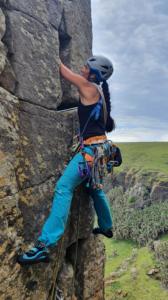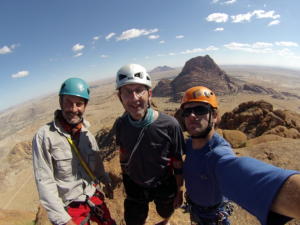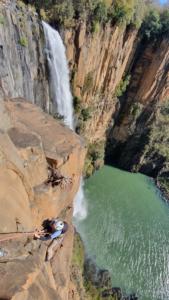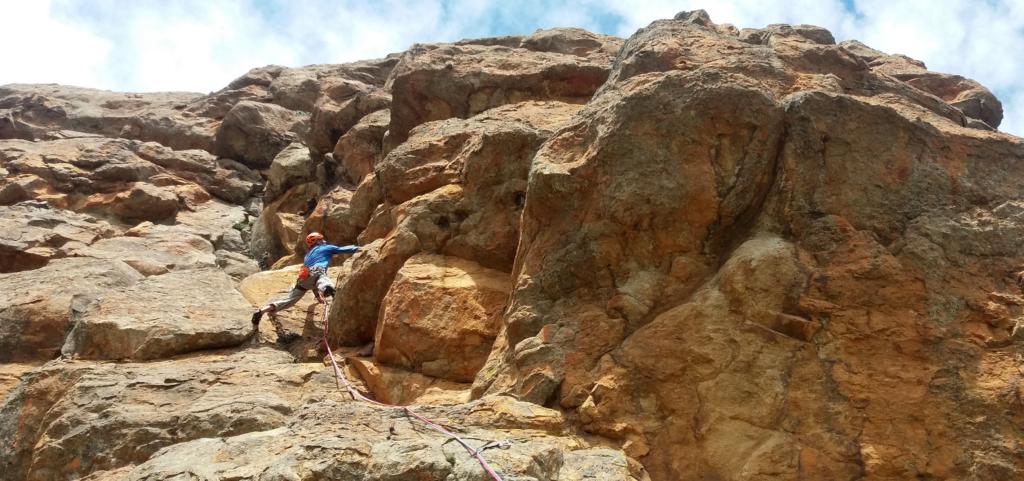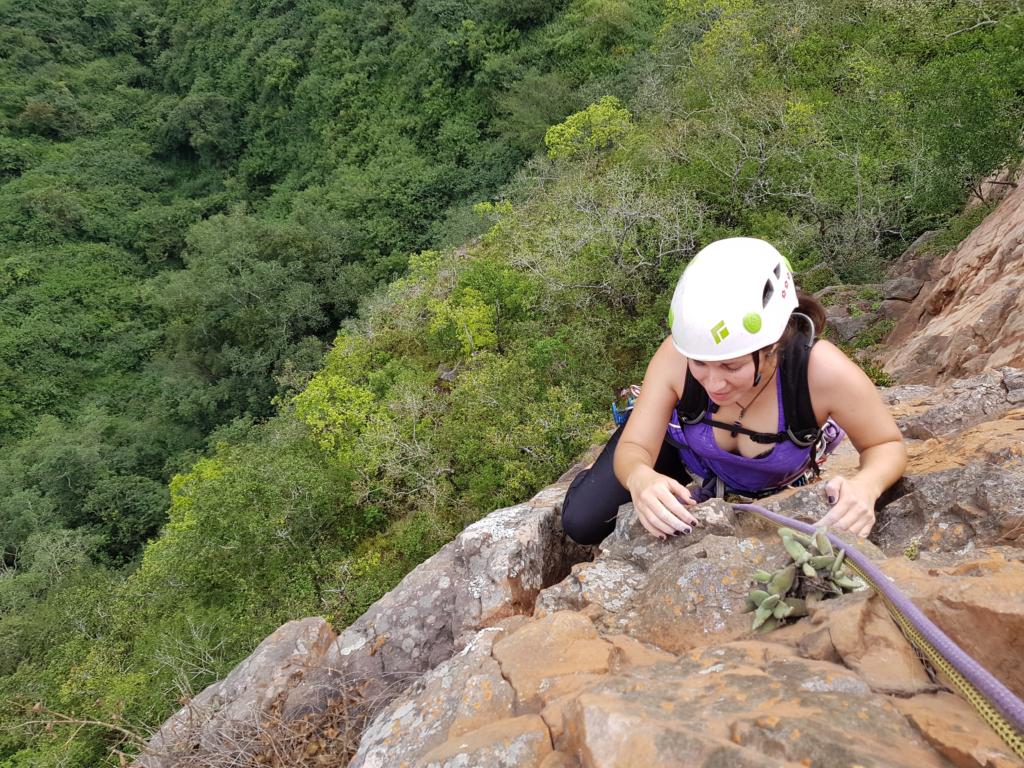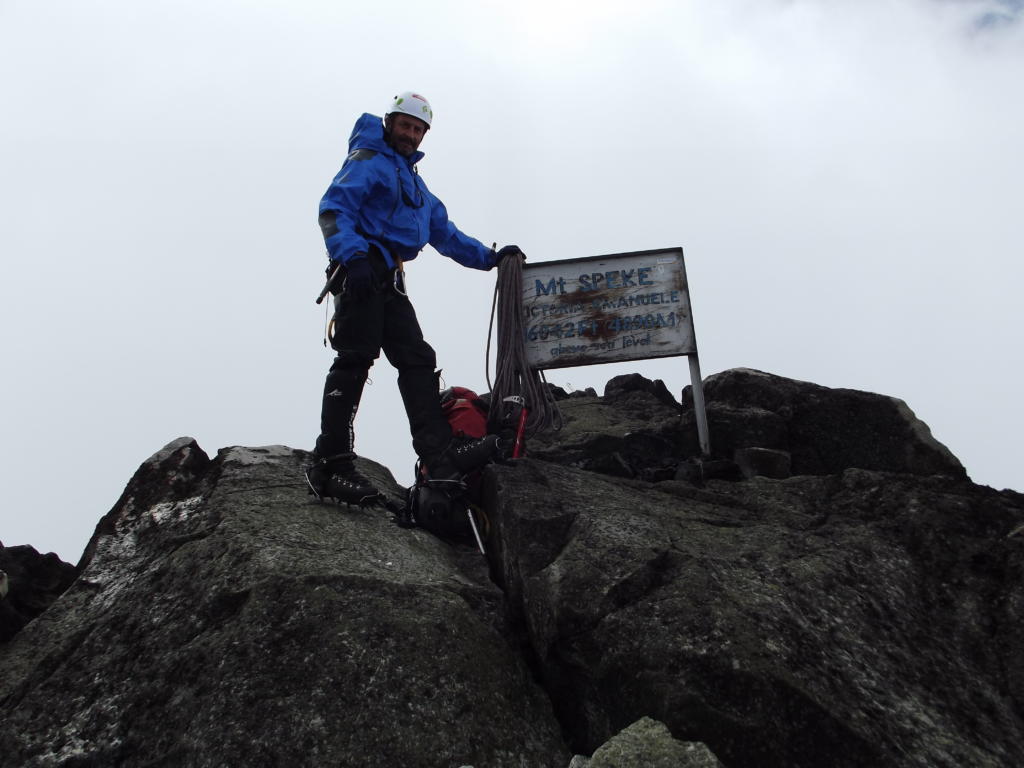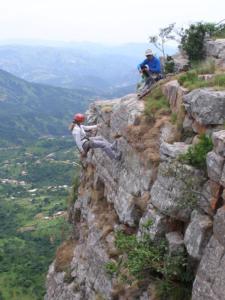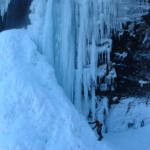Here are a few of the recent trips that PEAK HIGH has undertaken:
Multi-pitch Sport Climbing Course
One of my favourite courses! This happened as usual at Mount Everest Guest Farm near Harrismith, aka Eagle Rock, on 24th January 2024. It is always a pleasant environment of moderate sport routes and we did everything from how to change over and manage stances, to abseiling down multiple pitches to hauling a stuck climbing buddy. Mount Everest Guest Farm is the perfect venue for this course, as there are lots of easy to moderate bolted routes, up to 6 pitches in length. The accommodation is on the property and it is close the Gauteng (Johannesburg) area of South Africa.

Cleft Peak hike, via Camel Pass
On 8th January 2024, I did a four day trek on some steep paths and high drop off. This is a way of seeing some of the best of the Drakensberg. My client, who was only 23 years old was not really a hiker and did battle to do this route. His boots were also sub- standard and I ended up having to tape the soles on at times! This is normally a 4 day circular hike, but we decided to go to the summit of Cleft peak and
return the same way, and were home in 3 days.

Three, day hikes of hiking the northern Drakensberg
It is not often I get to do easy day hikes, but this was the exception. The added bonus was instead of being in a tent sleeping on the ground, I got to stay in hotels. We started on 6th December 2023 and my client was happy to go wherever I suggested and first off was the 14km out and back hike up the Tugela Gorge. Day 2 we hiked from Sentinel Car Park to the Tugela Falls, return. The final day was an easy stroll a Swinburne mountain, near Harrismith.

Sentinel Peak via the Angus-Leppan Route
Probably the best route in the Drakensberg and it never disappoints my clients! My UK client David was an experienced mountaineer out on a business trip. On 11th September, 2023, we
romped up the climb in good time. All 7 pitches and were down at the car by 3pm.

Mt. Kenya
In August ’22 Gavin took two clients to Mt. Kenya…click on the link below
https://peakhigh.co.za/blog/mt-kenya-august-2022/
Rooiberg
In January ’22 Gavin was guiding two British clients at Rooiberg, Cederberg mountains
Cobham
Gavin guided at Cobham in the southern Drakensberg
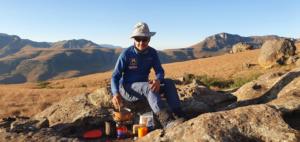
Ice climbing
Gavin Raubenheimer, ice guiding at Sani Pass in July ’22
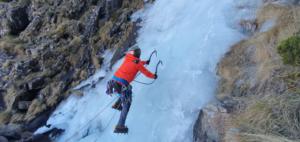
Bushman’s Nek
Peak High guided an international corporate group on a 3 day, 2 night hike at Bushman’s Nek, Drakensberg
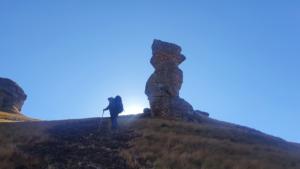
Spitzkop, Namibia- July ’22
A 3 day trip guiding a British client on the amazing granite of Spitzkop
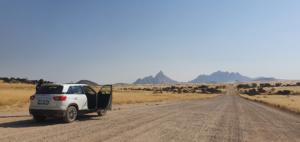
Magaliesberg
Simon Laker came to the Magaliesberg in May ’22. We did five multi-pitch routes in just 3 days!
Morgan Bay
Morgan Bay is where we ran an Abseil Suervisor course in February ’22
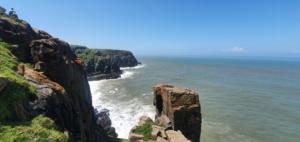
Multi-pitch Supervisor Course in Cape Town, March 2021.
This course has become popular for aspirant rock guides and for recreational climbers alike. As an M.I.A. these courses are perhaps the nicest to hold. I as the instructor get to climb lots and at the same time impart lots of knowledge. Multi-pitch trad and Sport climbs are seen as an ultimate goal for many. To get the skills needed and enough confidence to get out on a big wall is what many battle with and where this course helps so much.
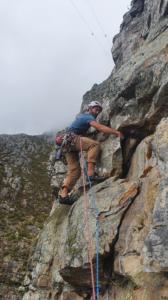
Mountain Leader Course, January and March 2021.
I run these courses in the Bushman’s Nek area of the Drakensberg. The Kwa-Zulu Natal Section Mountain Club of SA, booked with us and subsidised the course fee for 5 of their meet leaders. It is to raise the skill level of people who lead trips for the Club in the Drakensberg. Two course sessions have been run this year. We spent 5 days in each course doing anything from navigation to camp etiquette to river crossings.

Cleft Peak and Tseke Pass hike March 2021.
These were previous clients from seven years before, who came back for 4 days of hiking in the beautiful central Drakensberg. Autumn weather had set in and there was a slight chill in the mornings. We enjoyed great views, two lovely campsites and summited Tseke Pass. Cleft Peak unfortunately remained un-climbed as a thunderstorm moved in towards midday.

Sea cliff climbing at Morgan Bay, January 2021.
Its always a pleasure to climb on good rock with good views and easy access. My client has been climbing with me for just over a year. At 71 years he was a late starter in climbing! We have been all over including Monteseel, Shongweni , White Umfolozi and Swinburne. This time it was to be the dolerite cliffs above the Indian Ocean. 4 days of perfect rock followed by relaxing evenings at the Morgan Bay hotel.

Injasuthi Lower Traverse Hike 12-14 February 2020 with Bruce Morley
Bruce had been desperate to escape the ravages of corporate life in the big city. So this hike was his escape since the year before. Bad weather put that idea on hold in 2019, so I took him on this relatively easy route in 2020. But the bad weather returned just before we met and the Drakensberg was pouring water when we arrived at Injasuthi office. After packing bags and filling in the Mountain Rescue register we set off for Grindstone Cave. An easy 1.5 hour hike brought us to this lovely overnight stop complete with an old Zulu grindstone still lying nearby, hence the name of the cave.
Day 2 was a pleasant hike up and over a ridge and then down into the main Injasuthi River valley. A spectacular place, with high cliffs and thick indigenous forests and the highest mountain in South Africa, Mafadi, looming in the distance.
As we got into the main valley it became evident that the rains from a few days back had caused the river to run high. We moved on up the valley, often having to remove our boots, several times to cross the fast flowing waters. During that night as we cooked dinner in the Lower Injasuthi Cave the rain returned. It rained the entire night.
By morning, the river was running even higher than the day before. To get back to the road ahead involved some 7 river crossings, prompting me to eventually remove my boots and hike in “Crocs”, footwear normally reserved for campsite wear and middle of the night excursions to the bush. The crocs proved great for simply sloshing through the knee deep rivers and streams.
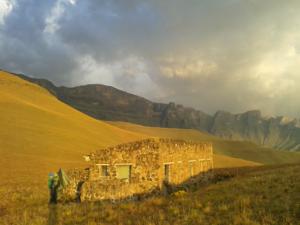
Injasuthi Centenery Hut

Injasuthi Grandstone Cave
Corporate group – Devil’s Knuckles hike.
This was a group of 12 corporate clients picked from around the world and 2 facilitators. The 12 all worked for one multi-national logistics company. Peak High’s job and me as a guide, was to get them safely from A to B then to C and finally back to the road-head. It all took place at Bushman’s Nek in the southern Drakensberg. I am rather sceptical of taking groups of non-hiking, office bound people and putting them into a hostile environment. But that’s what the facilitators wanted….including summiting the middle Devil’s Knuckle on day 2.
We set off heading for the Tarn Cave area and the intention was to camp in tents near the cave. The progress was painfully slow and most of the 12 were suffering from the excursion, altitude and wearing a backpack. The weather began to get dark and angry to our south by mid-afternoon. As we approached the final 2kms up a steep exposed ridge, lightning began hitting about 4kms away. No amount of encouragement helped in getting the group to move faster. Then heavy rain began to fall and then our pace dropped even more. By the time we got to the camping spot it was dark, wet and everyone was exhausted and I took the decision that everyone would stay in the cave that night, much to the facilitator’s disagreement. Rain fell the entire night and I turned the group around in the morning and we started back the way we had come. But by the time we got into the main valley again, the river was almost breaking its banks. Small side streams became raging torrents. We battled downstream for several hours before getting back to the vehicles. It was a reminder to me that mountain guiding, even in a place as gentle as the southern ‘Berg can be a taxing business.
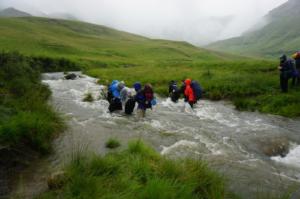
River crossing, Bushman’s Nek
Ice Climbing Skills Course– Rhodes July 2020.
We were in covid lockdown level 3 and Peak High was allowed to train people but not guide. Sani Pass and Giant’s Castle were out of bounds for ice climbing, but the little known ice venue above the town of Rhodes was open for climbing. After doing a recce trip 2 weeks before and climbing some nice, yet easy routes, I met up with my 2 clients in the little town. We soon set off up the steep roads to get to our “base camp” at the rather comfortable Hawk’s Head cottage, perched high above the Eastern Cape highlands. We spent 2 days doing all the relevant skills. Anything from seconding ice climbs to placing ice screws to French technique on easy angled faces. The clients loved it and it’s all in easy access from vehicles.
Sentinel, Angus-Leppan Route– July 2020
Luca, a long standing client, was keen for us to climb the Matterhorn this year. But with covid restrictions, that dream had to be put on hold. So he opted for a few local climbing trips including the famous Angus-Leppan route on Sentinel peak. It turned into a great little trip where we hiked into base camp at a little rock overhang the day before. After a pleasant night we climbed the 7 pitches and were on the summit by midday.

Highest mountain in South Africa, Mafadi– A hike to help save lives, October 2020.
Mafadi, which stands at 3451m above sea level, is the highest mountain in South Africa. It was also the objective of the SA Bone marrow donor organisation to have a donor stand on the summit and to take a genetic swab, to show how easy it is to help save lives.
They sent Clayton, a keen member of SA Bone Marrow and also a donor of the cause. It was set out to be a 3 day and 2 night hike and we reached the summit on schedule late on day two. Clayton, who is not a regular hiker was taking a lot of strain, yet he still took out the donor kit, took a mouth swab while I took the pictures. For a change the weather was bright and sunny (Mafadi, due to its height attracts lots of bad weather) and we had a great time standing about admiring the view. What lay before us was another days hike back to the car during which time I had to help my client at times as fatigue and blisters turned his trip into a marathon “vasbyt”.
Abseil Supervisor Course ,at Hogsback in the Eastern Cape, December 2020.
Hogsback is always a pleasure to visit and so training the Hobbiton Adventure Centre staff was a job I was very happy to take on-board. The Abseil Supervisor Award is an MDT endorsed qualification for just such places as Hobbiton. It is 4 days of skills training such as re-leasable abseils, prusiking and 3:1 haul systems.
MDT- Ice Climbing Skills Course – Bokong, Lesotho July 2018
A great three days at this seldom visited venue in the north of Lesotho, which forms a section of the greater Drakensberg. We had three clients, Natasha, Callum and Chase to get their first taste of ice climbing. Accommodation was in the usual rustic rondavels, just 100m from where the course was held. Day 1 was spent doing the very basics of ice climbing training and safety. Day 2 we abseiled (rappelled) into the main gorge and there top roped a WI 4 route, using various skills and techniques. To end off, the instructor led out of the gorge via another, but much easier route. This same route was used the next day for Callum who has previous rock climbing leading experience, to do his first ice lead. All in all a successful three days.
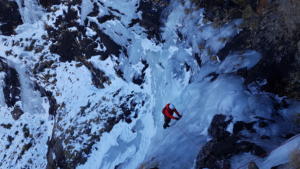 Photo: Bokong, Menage a Trois
Photo: Bokong, Menage a Trois
Hiking Monte aux Sources summit with Asheen from Cape Town. May 2018
Asheen likes bagging summits and needed to get some altitude fitness before heading off for the French Alps. He had set his sights on Monte aux Sources at 3282m, which is a simple hike to a high a lonely summit on the border of South Africa and Lesotho. We set off from Witsieshoek Mountain Lodge by road and left the vehicle at Sentinel car park. Straight away we set a fast pace and in less than one hour we were climbing the famous chain-ladders to the summit plateau and enterd the Royal Natal National park land. Another hour of fast hiking and we were on the summit with views of Cathedral Peak some 60kms away and even further to Champagne Castle.
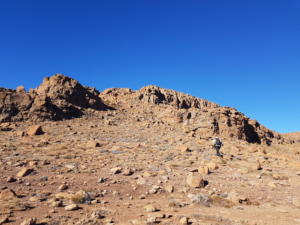
Photo: Monte aux Sources, near summit.
Cederberg, Montagu and Paarl Rock road trip– May 2018
All rock climbers like a road trip and my British client was in the mood for some high quality rock and leisurely evenings around the braai (barbeque). It was Simon’s third guided trip to South Africa in as many years, as I have guided him in the Drakensberg and on Spitzkop in Namibia.
After collecting our hire car and lots of food (and beer) we set out for Rooiberg in the southern Cederberg and established our camping area below the beautiful red crags. The camp ground had only 3 other people staying over. Here we spent the next 2 days climbing multi-pitch trad climbs of up to 5 pitches in length and then headed south to Montagu for 2 nights and climbed the classic 8 pitch sport route, Another Day in Paradise. On the last day, while on the way to the airport we sneaked in the uber classic, Sands of Time at Paarl Rocks outside Cape Town. Four pitches of granite sport climbing.
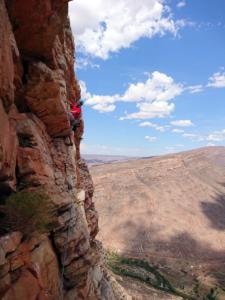
Photo: Cederberg Nuwerus
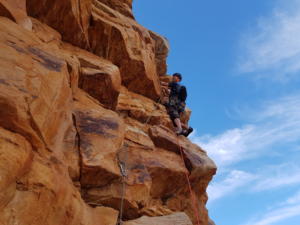
Photo: Cederberg Rooiberg, Meanderthal
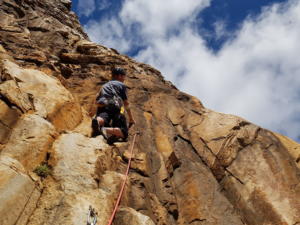
Photo: Montagu, another day in Paradice
By Dr Peter Robinson, Auckland, New Zealand
Gavin was our guide.
We were a group of 5 (4 of us are from New Zealand, and the 5th Is a South African) all around 50 with previous multi day hiking experience.
I grew up hiking in the Drakensberg but had never done the Bell Traverse so it was exciting to do this hike in my 50th year.
We decided to hire a group of porters so that we could travel with only a day pack and enjoy the scenery. Gavin organised the porters, all of whom have been trained by Peak High.
Apart from the luxury of not carrying a crippling, heavy pack, the porters were a great bunch of guys who also functioned as an unofficial security team which can be very valuable in South Africa.
Our hike was a 4 day/3 night round trip from Cathedral Peak Hotel. This hotel is a great place to start and finish the trip. It was founded by the Van der Riet family in 1939. My grandparents were friendly with the owners around that time and it has remained a well run establishment to this day. The accommodation is very good and the food is great. The hotel has a relaxed, safe, family feel. One can leave gear in the hotel lock room if one is returning after doing the hike. I would strongly recommend this, because apart from the convenience of leaving ones car and gear at the hotel, there is nothing like an ice cold beer or glass of bubbles, followed by a hot shower and hearty dinner after the hike.
We did the Bell Traverse in reverse which makes it more enjoyable (in my opinion).
We started walking late morning so elected to have a first night in Ribbon falls cave. This is a great way to break the steep climb up to the Drakensberg escarpment. The “shower” at this cave will certainly refresh you back to life!
Don’t forget the wet wipes for your other cave nights as water can be limited later.
Day 2 involved a fantastic, steep hike up the Camel and Windy Gap pass. The route is exposed in places but absolutely fine if one is careful and way easier if carrying a day pack.
The second night involves staying in a spectacular Cave which is reached by a hugely exposed traverse. Gavin kindly fixed a hand rail for security on this traverse. Thankfully there is another option for those that don’t like the traverse- a great little cave about 800m to the West. However, sleeping more than 2 in this cave would be a tight squeeze.
Day 3 involved a spectacular but easy hike to the summit of Cleft Peak (3277m). The views from the summit are amazing. We traversed the escarpment and eventually dropped down to Twins Cave. This is a large, well sheltered cave with beautiful views down over Kwa-Zulu Natal.
Our final day was the prize of the hike: magnificent views of the inner and outer horns, the Mitre, the Bell and Cathedral Peak. There were a few short sections of exposed scrambling and areas where the narrow path felt very exposed. However, with the light packs, the “warm up” on the previous 3 days and a bit of focus and concentration it was fine.
There is the option of also climbing Cathedral Peak (3004m) at this point. However, if doing the traverse over 4 days, one needs to get to the top of the escarpment on day one, to allow time to climb this peak on the final day. However, two of us had previously climbed this peak (as a day trip from Cathedral Peak Hotel) and we were out of time, so we enjoyed the views and cruised on down to the hotel.
I will never forget the feeling of peace and satisfaction of sipping a glass of champagne and looking up at the Bell Traverse and knowing that we had finally done it.
Overall, this was definitely one of the best hikes I have done- and I have hiked extensively around the world. Gavin is a fantastic guide and not only did he make the hike possible, but he also enhanced our trip with great stories and knowledgeable anecdotes along the way.
Gavin is a superior guide with extensive experience and skill. He is also an ambassador of his passion for the mountains, being a past president of the Kwa-Zulu Natal section of the mountain club, overseeing mountain search and rescue in the area, and involved in maintaining climbing standards and instruction.
In summary, the Bell Traverse is an exceptional hike and Gavin an exceptional guide for it! Challenges and rewards await each day.
However, (and a special note here for fellow foodies); be aware that back-country fare is very simple (light to carry and quick to prepare), it is after all, a high mountain hiking trip, not a gastronomy tour. We were very glad that we took a good stash of biltong, droewors and dried fruit with us to share …and at trail’s end, an extraordinary culinary reward awaited our return to the valley at the hotel!
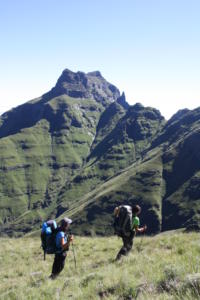
The northern Drakensberg can be very wet during January, but this time around we hit it lucky. There was good weather the entire way except for some cloud and mist at the top of Mlambonja Pass, which caused some careful navigation. I was guiding four ladies from the Gauteng region. All of them experienced hikers but wanted to get to know the Drakensberg better. We hiked the route over 5 days and 4 nights and had great views of Cathedral Peak, Champagne Castle and Monte-aux-Sources.
By Riana Knouwds, Vereeniging, South Africa.
In 2016, I realised I really wanted to explore the Drakensberg wilderness area. I needed an experienced guide who knows the Drakensberg and who would take the challenge to take four of us,.. eager woman from Vereeniging… to experience the Drakensberg first hand. Researching on the internet… I came across “Love Wild Africa” reference of a hike with beautiful photos taken by the photographer Scott Ramsay, where Gavin took two of his friends on the Mini Transverse. I came across gavin@peakhigh.co.za and read about Gavin Raubenheimer. I took a chance and send a short email to ask if he would be interested in taking us on the Mini Transverse…Surprised…I actually didn’t think I get a yes for an answer. Gavin Raubenheimer is an awesome, passionate skilled guide with extensive knowledge and experience of climbing ,hiking, navigating rescuing and handling groups in difficult scenarios of the weather elements and situations in the wilderness area of the Drakensberg.
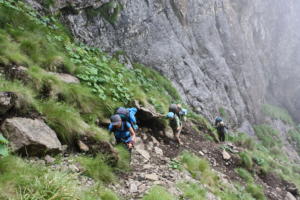
During our trip in January 2017 we experienced Gavin as an experienced and passionate guide knowing what to do and how to handle us…our pace … the hike…when the weather elements changed (heavy mist ,rain and lightening) to keep us save with good navigation skills and experience the different scenarios as exciting challenges. He also understands the culture and knows how to handle the Lesotho people (young shepherds) we
encountered on the route.

Experiencing the Ifidi cave ,Ledgers cave, Twin cave and camping in tents in the open, swimming, resting, the mystical views and challenges in the mist, the challenging Bell Transverse and Bugger gully, Orange peel gap,was an unforgettable” living life in the full ”…. life changing experience so much so that we asked Gavin to take six of us on the next experience in 2019 from Cathedral peak to Monks Cowl!! (Central Drakensberg)
South Korean Film group – February 2017
At Peak High, we do some interesting and different jobs at times. This time around was guiding and being interviewed for a South Korean TV channel that features great hikes from around the world. I took them up the Rockeries Pass area of the northern Drakensberg for 3 days, where they filmed from land and from a drone. They used the time to eventually gather enough material for two 30-minute episodes, which will be screened in May 2017.



Simon Laker from the UK, has been a Peak High customer before when we guided him in the Drakensberg. This time he opted for the “Matterhorn of the desert”, Spitzkoppe in central Namibia. I drove the 2200kms from South Africa and met him there for 5 great days of desert friction climbing. We climbed the uber classic To Bolt or Not to Bolt, which is an 8 pitch grade 6a route on Pontok Spitz. We also did two other routes on Sugarloaf and perhaps the feature was climbing The Rhino’s Horn. This being a single pitch grade 6b route to the tiny summit of the horn followed by a breath taking abseil.
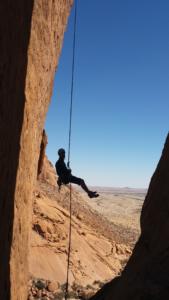
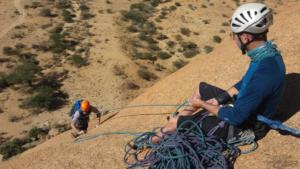
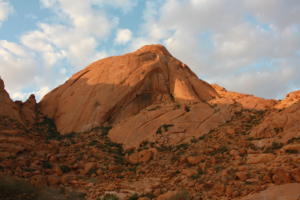
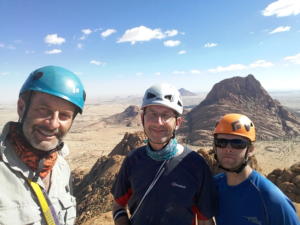
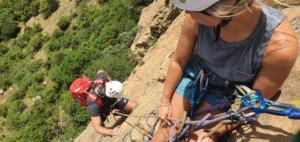
 Follow
Follow
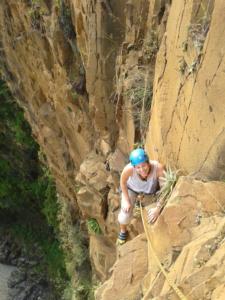
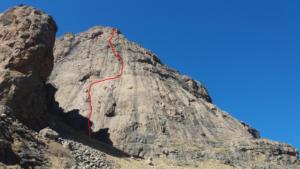
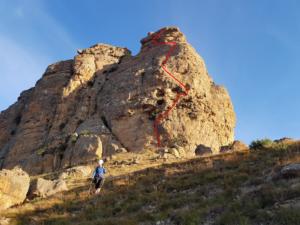
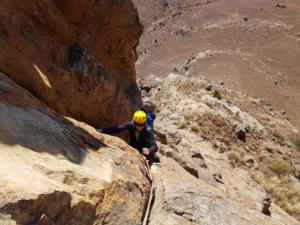




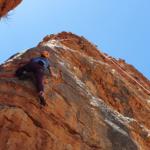
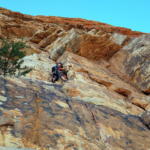




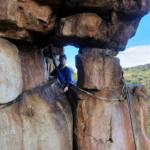
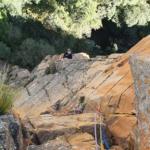









 Photo: Bokong, Menage a Trois
Photo: Bokong, Menage a Trois


















